Great Grimsby Street Tramways
History
Powers to build a standard-gauge horse tramway, wholly within Grimsby, were obtained on the 21st July 1879 under the Great Grimsby Street Tramways Act, 1879. The act also incorporated a company — the Great Grimsby Street Tramways Company — to build and operate the line, which at some point after its incorporation, became a subsidiary of the Provincial Tramways Company, which was no doubt heavily involved in financing it.
The PTCo, which was registered in London on the 10th July 1872, was involved with tramway operation for over fifty years, either owning, controlling or leasing the following: Cardiff Tramways (1872-1903); Cardiff District and Penarth Harbour Tramways (1888 to 1903); General Tramways of Portsmouth (1878-1883); Gosport and Fareham Tramways (1905-1929); Gosport Street Tramways (1882-1883); Great Grimsby Street Tramways (1881-1936); Landport and Southsea Tramways (1878-1883); London Southern Tramways (1883-1906); Plymouth, Stonehouse and Devonport Tramways (1872-1922); the Portsdown and Horndean Light Railway (1903-1935); Portsmouth (Borough), Kingston, Fratton and Southsea Tramways (1885-1892); and Portsmouth Street Tramways (1874-1905).
The 3.8-mile long tramway was opened on the 4th June 1881, and was operated for six years before powers were sought to extend it — 1.17 miles — towards Cleethropes. The powers were obtained on the 25th September 1886 via the Great Grimsby Street Tramways (Cleethropes Extension) Order, 1886, which was authorised under the umbrella of the Tramways Orders Confirmation (No. 1) Act, 1886. The new extension, which was opened on the 21st May 1887, still ended some way short of Cleethorpes promenade and sea front (which was the destination of the majority of passengers) due to Isaac's Hill, which was considered to be too steep for horse traction. This remained an obstacle for over a decade, the company eventually gaining powers — on the 6th August 1897 — to ease the gradient and to extend the tramway a further 0.42 miles. These powers were granted under the Great Grimsby Street Tramways Extension Order, 1897, which was authorised by the Tramways Orders Confirmation (No. 2) Act, 1897.
The extension, which was opened on the 4th September 1898, took the horse tramway system to its maximum extent of 5.26 miles. The system comprised a circa 4-mile main line between Grimsby and Cleethorpes, with a one-mile branch line running south through Grimsby. The western terminus was situated outside the Wheatsheaf public house in Bargate, from where the line ran northwards over the Manchester, Sheffield and Lincolnshire Railway Company's line (by a bridge), before turning eastwards along Victoria Street, which it followed to Riby Square, crossing the railway via a level crossing, then eastwards along Cleethorpes Road, parallel to the Humber, to a terminus on Cleethorpes promenade in Albert Road; the branch line ran southwards from Riby Square along Freeman Street and Hainton Avenue to a terminus at the latter's junction with Tasburgh Street.
The tramway was heavily loaded and was operated very profitably for just over 20 years. The only cloud on the GGSTCo's relatively uncluttered horizon appeared in the late 1890s when local interests started a discussion around building and operating an electric tramway, the corporation having already held powers for electric lighting and supply since 1894. The PTCo was, however, reasonably quick out of the blocks, no doubt spurred on by its experiences elsewhere — Cardiff and Portsmouth Corporations both obtained powers in 1898 to construct municipal tramways and compulsorily purchase the local horse tramways, worked by the PTCo — beginning the process of negotiation with Grimsby Corporation and Cleethorpes UDC in 1897.
Whilst Cleethorpes quickly agreed with the GGSTCo's plans, Grimsby were more circumspect, and clearly knew that they had the company over a barrel, given that they had the right to purchase most of the horse tramway 21 years after the enabling act, i.e., in 1900. The company was certainly not going to undertake a major investment unless it stood a reasonable chance of getting its money back, and wanted both authorities to formally postpone their right to buy for another 21 years. Agreement was eventually reached, with Grimsby managing to extract an impressive list of concessions from the company, which in addition to entirely funding the reconstruction of the tramway and equipping it for electric traction, included a blanket fare of 1d within the borough, a commitment to take a minimum number of units of electricity per annum from the corporation, payment of way leave (again per annum) and even road widening. The fact that the company agreed to these fairly onerous terms is probably a reasonable indication of how profitable the PTCo thought an electrified GGST could be.
Having gained the buy-in of both local authorities, the company applied for powers to convert the tramway, the first of these being granted on the the 1st of August 1899 under the Great Grimsby Street tramways Act, 1899, and the second (further lines) on the 30th July 1900, under the Great Grimsby Street Tramways Act, 1900.
Work on converting the horse tramway started in late 1899, with a new southbound track around the Market Place being opened for the horse cars in December 1900, and some of the new extensions in October 1901. The last horse trams finally ran on the 6th December 1901, the full electric system opening the following day.
The new system was essentially a rebuilding of the horse tramway — most of the main line being doubled — with some modest extensions, namely: from the old Cleethorpes terminus at Albert Road eastwards along High Cliff Road to Brighton Street; from the Wheatsheaf terminus eastwards along Welhome Road to the Peoples Park; and from Tasburgh Road terminus southwards to Welcome Road. It was envisaged that the latter two extensions would eventually be joined to form a loop line, but this was destined never to happen, largely due to the Great Northern Railway Company, which successfully objected to the running of trams over the level crossing on Welhome Road. The tramway was only ever extended once, the short distance from Brighton Street to the start of Sea Bank Road — later called Kingsway — which was protected by newly constructed sea defences; this was officially opened on the 12th July 1906, and took the system to its final size of 6.3 miles.
As the company had hoped, the tramway was very profitable, new tramcars being quickly ordered to supplement the increasingly overloaded fleet, with a programme of top-covering also being conducted throughout the late-Edwardian era. Unusually for a British tramway, the GGST also had half-a-dozen trailers; these were pressed into service on football match days and high holidays, but as each needed a brakesman and a conductor, in addition to those on the towing vehicle, it is not clear whether they were any more economical than working two separate tramcars.
Plans were made to connect the GGST to the Grimsby and Immingham Electric Railway (a tramway opened in 1912), via a junction in Victoria Street; however, the two systems were separated by an antiquated swing bridge over the Alexandra Dock, which was not rebuilt until the late 1920s, by which time the decision had been taken — by the then owners, Grimsby Corporation — that the future lay with trolley and motorbus operation.
Like most tramways, the GGST suffered during the Great War from a loss of manpower, and an inability to do anything other than minimal maintenance, due to a shortage of skills, lack of spares, and government restrictions on purchasing new track and/or tramcars. As a result of this, and the heavy war-time loadings, by 1918 the track and the tramcars were in pretty poor condition. After the war, the GGSTCo quickly set about rectifying the defects, including motorising four of the trailer cars and completely rebuilding several others, though it was reluctant to invest more than it absolutely had to, particularly in the track, given that Grimsby Corporation would shortly have the option to compulsorily purchase the tramway.
The corporation had in fact had the option to take over the tramway in 1911 as a going concern, but chose not to do, presumably because it would have been fairly pointless given the extremely good bargain that it had originally driven. By the early 1920s, however, public feeling had very much swung in favour of municipalisation, the corporation serving notice on the company — on the 18th July 1921 — of its intention to purchase the tramway on the 21st July 1922. The purchase was, however, far from straightforward, the corporation only having the right to purchase the portion within its municipal area, the rest of the system, i.e., the lines in Cleethorpes (and the depot) remaining with the GGSTCo. The company had envisaged such a scenario in 1911 when the corporation waived its right to buy until 1922, and had, with great foresight, induced Cleethorpes UDC to postpone its right to buy its share of the tramway until the 1st August 1930. The company now had the upper hand, as there was legal precedent for a municipal authority purchasing only a portion of a tramway, and having to not only buy the tramway, but also to compensate the company for the severance of its system.
Given the run-down state of the system, the company offered to settle for £80,000, and was almost certainly prepared to settle for significantly less, but was turned down flat by the corporation. Matters ended up in arbitration, which not only took time and money, but ended with the corporation having to pay £24,000 more than the company had offered to settle for. The company probably thought all its christmases had come at once, as this was a very hefty price for a fairly run-down tramway, and not even a full system. No doubt there was some explaining to do in the council offices, as not only was the price high, but on top of that, a tramway depot had to be built, a large number of serviceable tramcars needed to be obtained, and much track would have to be replaced.
The corporation took possession of its share of the tramway on the 6th April 1925, the company temporarily stabling the corporation's trams at Pelham Road depot until such time as Grimsby could build and equip its own depot, both parties also agreeing to inter-running.
The GGTCo had unsuccessfully experimented with a motorbus service as early as 1909, later that year handing over all motorbus operation to its parent company — the PTCo — probably for legal reasons. The motorbus side was gradually expanded by the PTCo, both services and excursions, the former running throughout the Great War, and then on into the 1920s. The PTCo successfully objected to the corporation acquiring powers to operate motorbuses in 1921, though in 1927, when the corporation tried again, the outcome favoured the corporation. Seven years later, however, the PTCo decided to exit bus operation in Grimsby, selling its motorbuses to Grimsby Corporation in 1934, but retaining those operating in Cleethorpes and beyond.
The problems caused by the ageing tramcar fleet were to some extent ameliorated in 1930 through the transfer of a dozen open-topped tramcars from the Gosport and Fareham Tramways, another PTCo tramway, which had just closed.
Cleethorpes UDC had obtained powers to operate a municipal tramway and trolleybus system as far back as 1928, but could not agree a price with the company to take over on the 1st August 1930, and was unwilling to go to arbitration given Grimsby Corporation's experience. With Grimsby Corporation actively replacing its trams with trolleybuses, the company offered to sell the tramway and its remaining motorbus operations to Cleethorpes in September 1935, at a price agreeable to both; the council took possession on the 15th July 1936, marking the end of the PTCo's involvement in the area after some 55 years.
Uniforms
In common with many horse-drawn tramways, staff operating the horse-drawn services wore robust but informal attire. Drivers usually wore a smart jacket and trousers, along with a coachman's coat (or similar) and a bowler hat, though by the mid 1890s, the latter was increasingly being superseded by the flat cap; conductors tended to be very young in the first decade of operation, again wearing robust jackets and trousers, but with closely fitting flat caps. No badges of any kind were carried, inclusive of licence badges.
Following electrification, tramcar crews were issued with double-breasted jackets with four pairs of nickel buttons bearing a monogram of system initials (see link), three waist-level pockets (with flap closures) and lapels; the jacket collars appear to have borne an embroidered badge of some description, possibly a grade or system initials. The caps were soft-topped with a glossy peak, and were relatively squat; photographs suggest that they may have borne embroidered script lettering badges, though the precise form cannot be made out on the surviving photographs. At some point, probably in the late-Edwardian era, a change was made to a markedly more robust design of jacket, though very similar to the original in style; the collars bore individual metal initials — 'G T C' — on each side, presumably in nickel to match the buttons. The peaked caps were probably changed at the same time to a smarter tensioned-crown (top) type; like the collars, they bore 'G T C' in individual nickel initials. It is unclear why the GGSTCo chose to proclaim their full title on the tramcar rocker panels and the full initials on the buttons, but then saw fit to use a shortened form on the caps and collars.
A few photographs exist which suggest that a new cap badge — possible circular in form (or diamond-shaped) with a horizontal bar — was introduced in the 1930s; an example of this badge has yet to come to light, so the precise details remain unknown.
In the electric era, tramcar crews were also provided with heavy double-breasted top coats, if the photographs are to be believed, greatcoats for motormen and overcoats for conductors; the greatcoats had high fold-over collars whereas the overcoats bore lapels. Both styles appear to have been worn without insignia in the early years, but later on bore metal 'G T C' initials on the collars.
A single photograph has survived from the horse-tram era that shows an individual in a kepi-style cap, who may well be an inspector, though this is far from certain. During the early electric era, it is possible that inspectors wore virtually identical uniforms to the tramcar crews, only differing in the embroidered grade (presumably). By 1933, and probably for a long time prior to this, inspectors were wearing typical tramway inspector garb, namely: single-breasted jackets with hidden buttons (or more likely a hook and eye affair), edged in a finer material than the main body, and with stand-up collars; the latter probably bore the grade — 'Inspector' — in embroidered script lettering. The peaked caps were of the tensioned-crown type; they probably bore the grade in embroidered script lettering (on a hat band), though this cannot as yet be confirmed photographically.
In common with the vast majority of UK tramway systems, the GGSTCo employed women during the Great War — as conductresses — to replace male staff lost to the armed services; unfortunately and to date, photographs that unequivocally show these ladies are yet to come to light.
Further reading
For a history of the Great Grimsby Street Tramways Company, see: 'The Tramways of Grimsby, Immingham and Cleethorpes' by J H Price; Light Rail Transit Association (1991).
Images
Horse tram drivers and conductors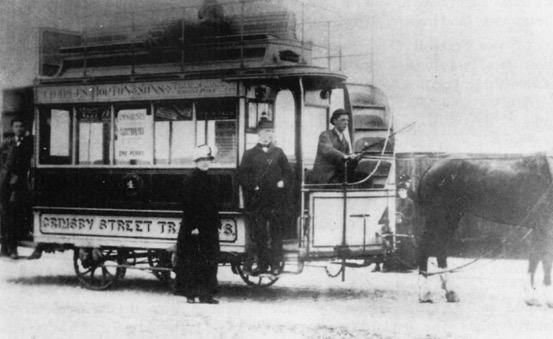
An early shot of one of the GGSTCo's original one-horse vehicles — photo undated, but judging by the good condition, probably taken in the early-to-mid 1880s. Both the driver and the conductor (the latter at the rear) are wearing informal attire. The cars were so short that a shortened form of the company name was applied to the rocker panel. Photo courtesy of the Tramways and Light Railway Society, with thanks to David Voice.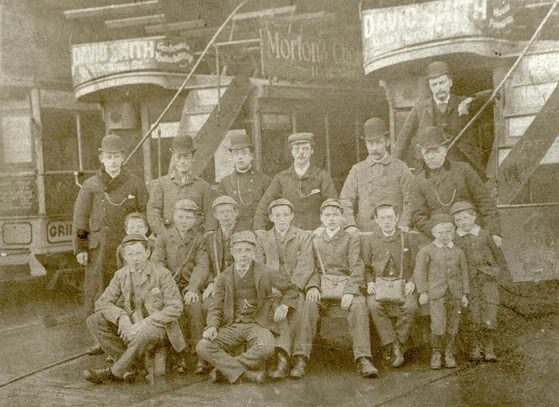
A staff photograph taken at Carr Lane depot (later renamed Park Street) in 1885. The men at the rear are presumably drivers — most in bowler hats — whilst the boys at the front, with cash bags, and in flat caps, are conductors. Photo courtesy of the Jill Smith Collection.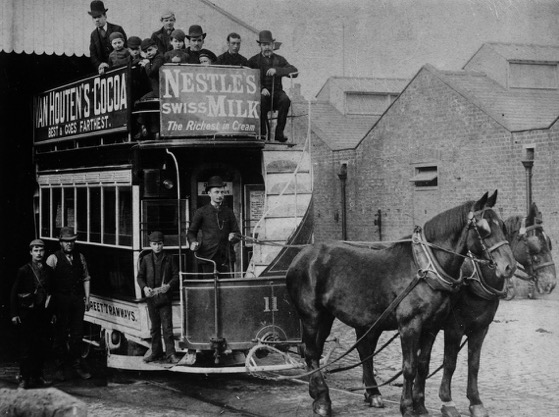
What would appear to be a virtually new Horsecar No 11 outside Carr Lane depot, dating the photograph to 1890. Photo courtesy of the National Tramway Museum.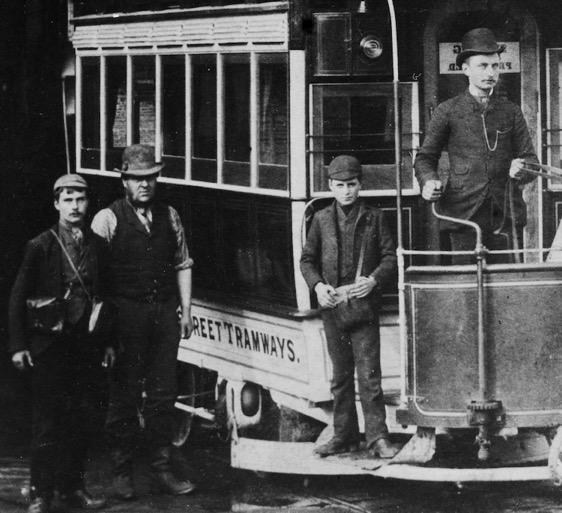
An enlargement of the above photograph showing the driver (on the platform with reins in hand) and two conductors (the boy on the platform and the individual on the extreme left), all of whom are wearing informal attire without insignia of any kind.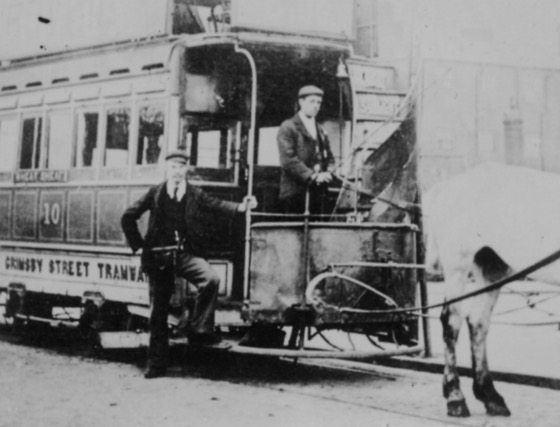
The crew of Horsecar No 10 pose for the cameraman at the Albert Road terminus in Cleethorpes in 1890. Both men are wearing informal attire. Photo courtesy of the Tramways and Light Railway Society, with thanks to David Voice.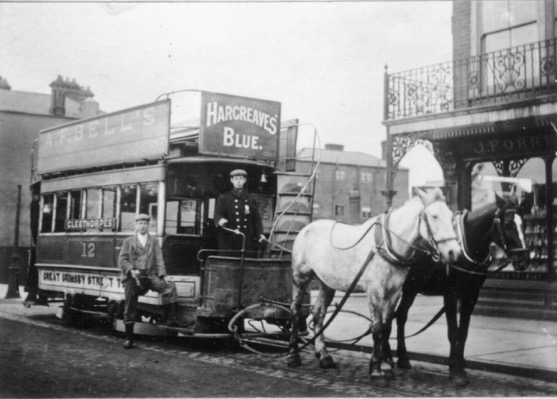
The crew of Horsecar No 12 pose for the cameraman, again at the Albert Road terminus, but this time in 1900; this vehicle was the second horsecar to carry that number. Photo courtesy of the Tramways and Light Railway Society, with thanks to David Voice.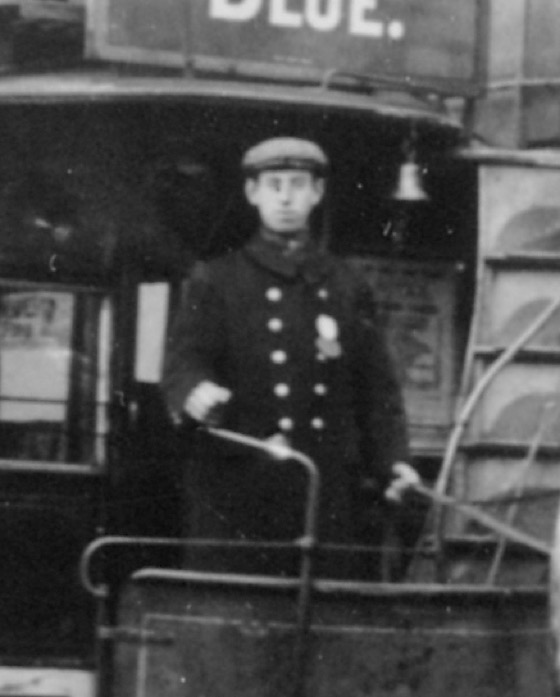
An enlargement of the above photograph showing the driver, in flat cap and what is probably a self-purchased greatcoat. Whilst the round object on his left breast could be a municipal licence badge, no other photo shows one, so in all likelihood it is not.
Motormen and conductors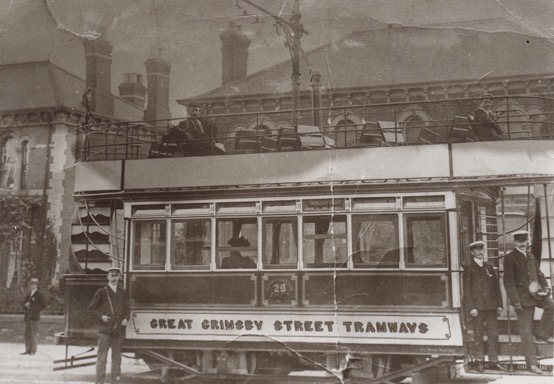
A posed photograph of GGSTCo No 25, which judging from its excellent condition, was probably taken in the year it entered service, 1903. Photo courtesy of the Jill Smith Collection. 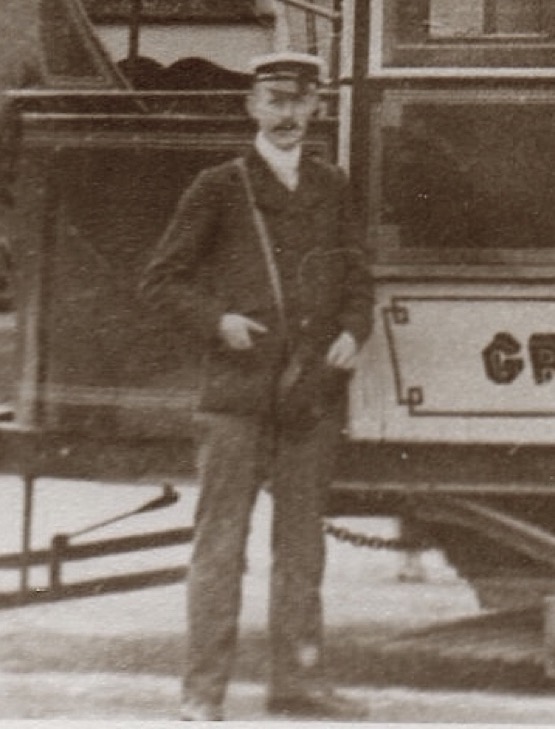
An enlargement of the above photograph showing the conductor. It is very difficult to judge whether the jacket and cap carry badges, but if so, then they would have had to have been embroidered given the lack of a reflection.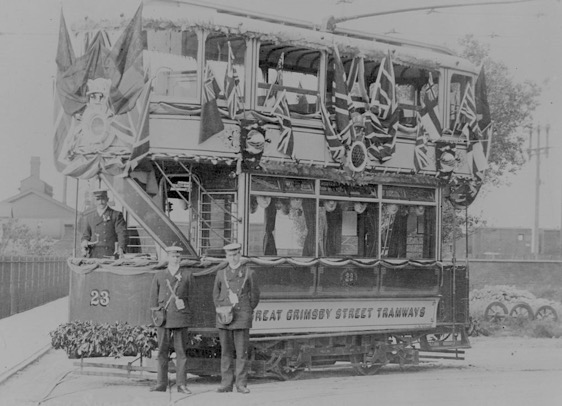
Tramcar No 23, decorated for the coronation of George V, is pictured outside Pelham Road depot in June 1911. Photo courtesy of the National Tramway Museum. 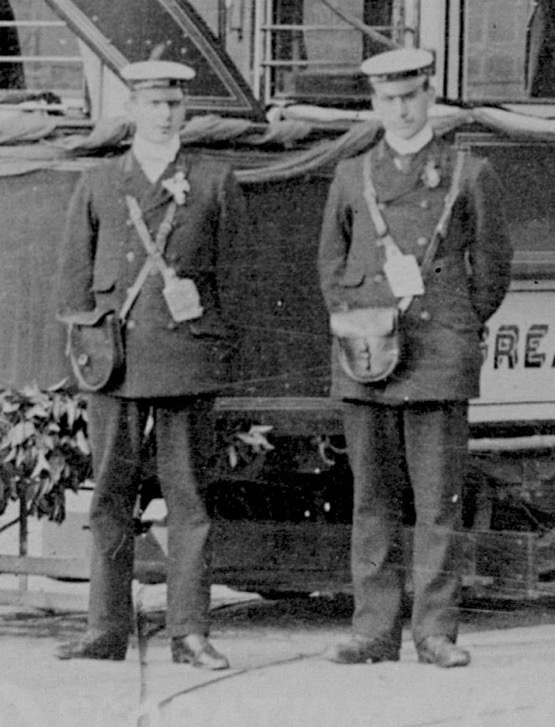
An enlargement of the above photograph showing the two conductors. The collar insignia appear to be embroidered, whilst all that can be seen on the rather squat peaked caps are the reflections from the shiny chin straps.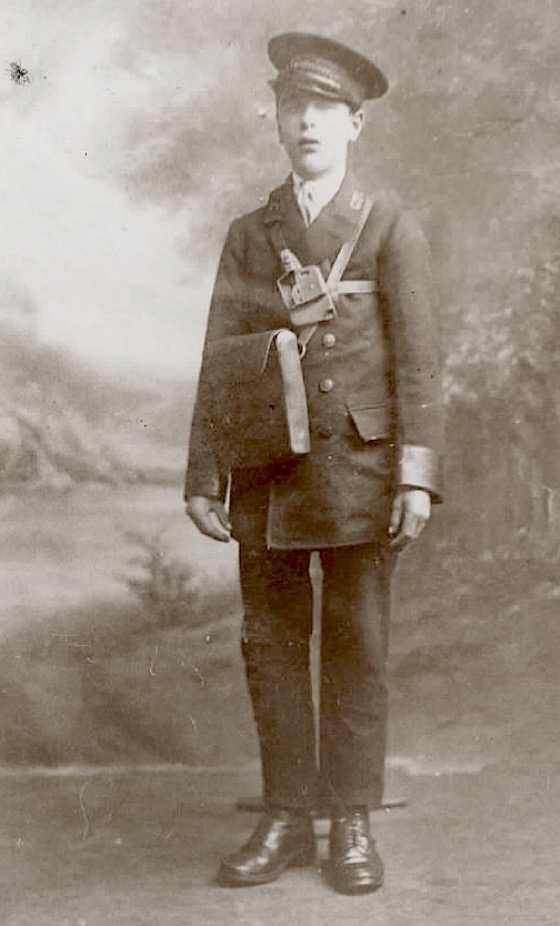
A rather youthful-looking GGSTCo conductor, suggesting that the photograph was taking during the Great War when many older company employees signed up for the armed services. His collar insignia appear to be 'G T C', rather than the full company initials, which would have been 'G G S T C'. Although there is no sign of a cap badge, it may well be there, but obscured by the large crown. Photo courtesy of the Stephen Howarth Collection.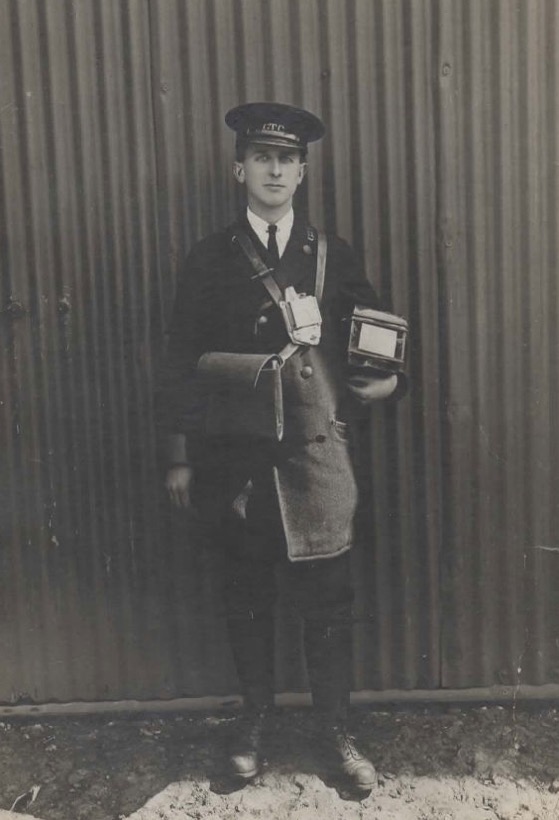
A GGSTCo conductor — photo undated, but probably taken in the 1920s. Although he could be a bus conductor, this seems unlikely given that the GGSTCo worked the buses under the name of its parent company, 'The Provincial Tramways Company'. Photo courtesy of the Jill Smith Collection.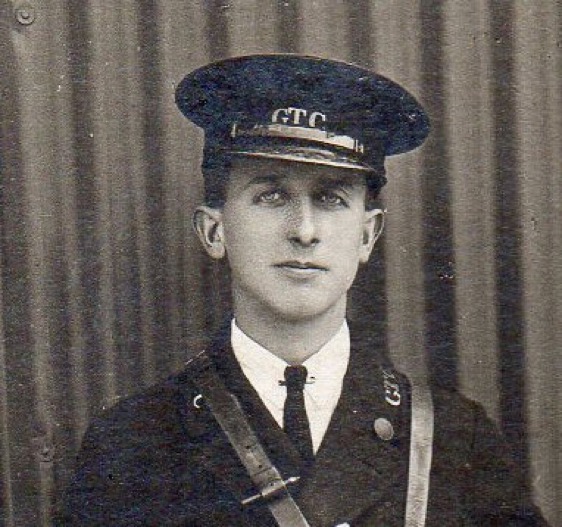
An enlargement of the above photograph showing details of the cap and collar badges, both made up of individual metal initials, 'G T C'.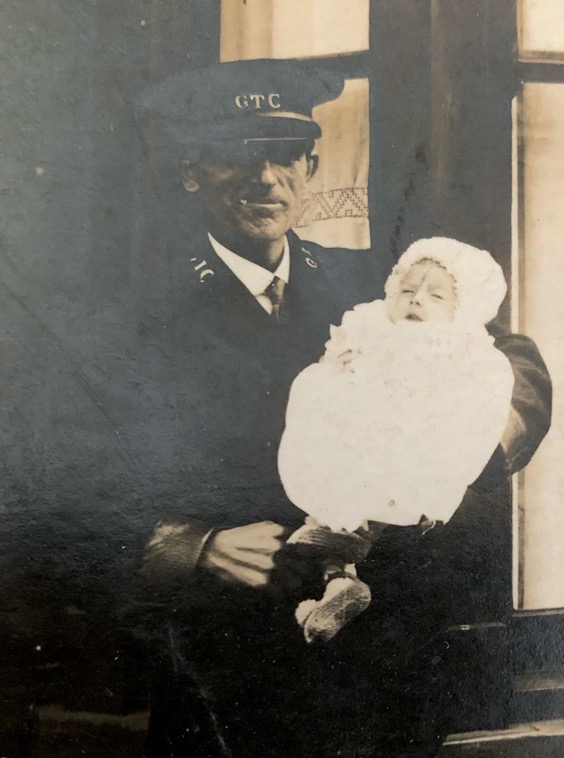
A family snap of Conductor Percy Dennis and his daughter, taken in 1920. The cap and collar insignia, all individual metal initials — 'G T C' — are easily made out. Photo courtesy of Neal Bower, Percy Dennis's grandson.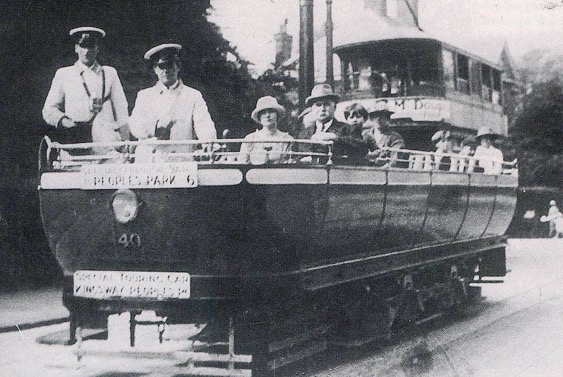
A rather poor-quality photograph, but one which shows a crew in light-coloured dust jackets at the helm of open-top 'Tram Coach' No 40 — photo undated, but definitely taken between its introduction in 1921 and its departure to the Portsdown and Horndean Light Railway (another subsidiary of the Provincial Tramways Company) in early 1925. The conductor is wearing individual 'G T C' initials on his cap. Photo courtesy of the Tramways and Light Railway Society, with thanks to David Voice.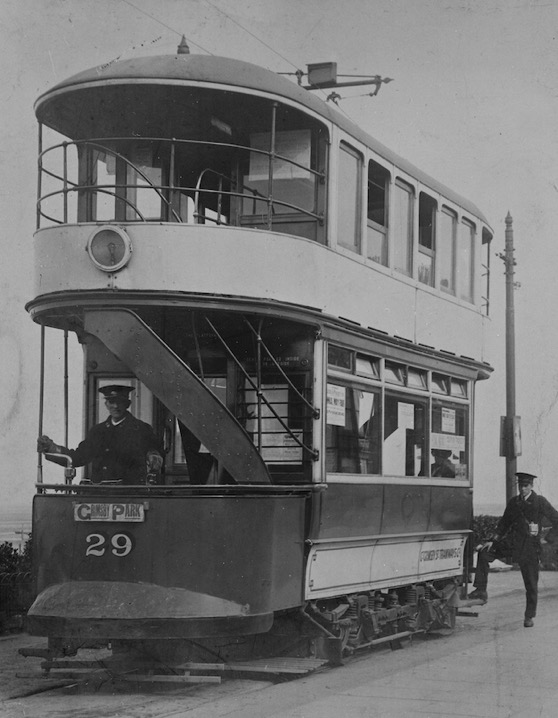
Tramcar No 29 standing at Cleethorpes — photo purportedly taken on the last day it carried this number (it was renumbered '8' in 1929), though it is still in war-time livery so may well have been taken earlier. Photo by D H Yarnell, courtesy of the National Tramway Museum. 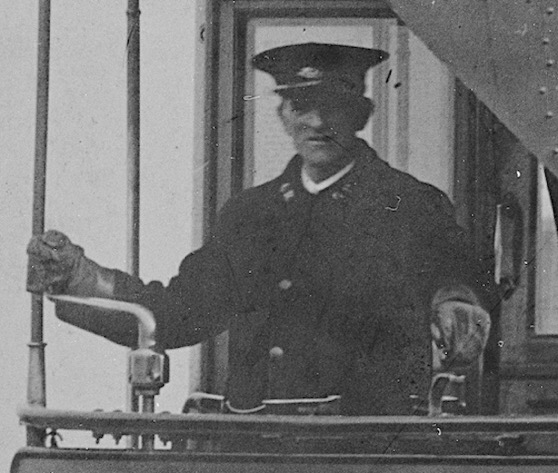
An enlargement of the above photo showing the motorman, Percy Dennis, who had by this time moved on from conducting; he would appear to be wearing a script-lettering 'Motorman' grade badge on his cap.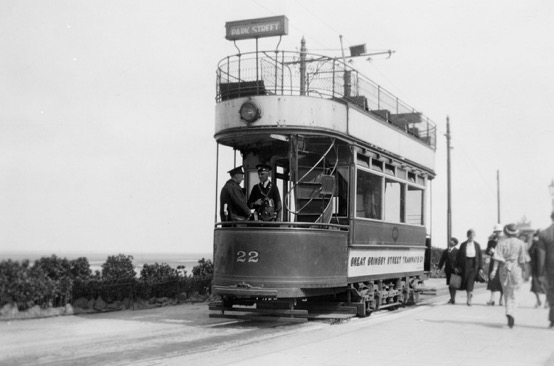
The crew of Tramcar No 22 (ex Gosport and Fareham Tramways) chat whilst waiting at the Kingsway terminus in Cleethorpes on the 25th June 1933. Photo by M J O'Connor, courtesy of the National Tramway Museum. 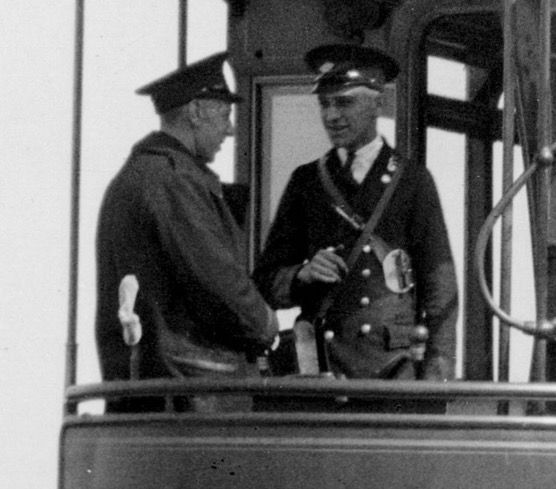
An enlargement of the above image showing the motorman and conductor. The conductor's left-hand lapel bears individual system initials — 'G T C' — whereas his cap appears to bear a badge that is roughly diamond shaped, or possibly round with a horizontal bar.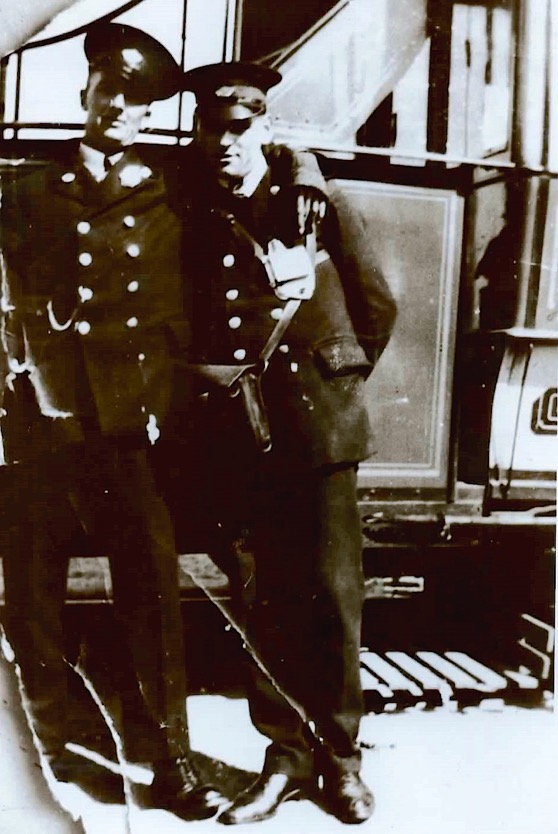
The crew of an unidentified tramcar — clearly good mates — pose for the camera late in GGSTCo days; the conductor is B Robinson. Both men are wearing a cap badge that appears to be circular with a horizontal bar. Photo courtesy of the Jill Smith Collection.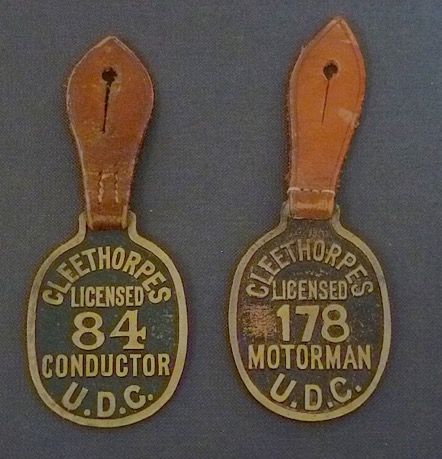
Cleethorpes Urban District Council 'CONDUCTOR' and 'MOTORMAN' licence badges — brass. These badges are presented for interest, as there is currently no photographic evidence whatsoever to suggest that they were ever worn by Great Grimsby Street Tramways Company tramcar crews. Authors Collection.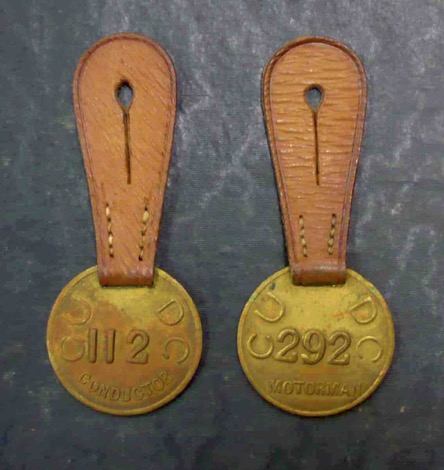
These licence badges are also purportedly from Cleethorpes, and are again presented for interest. There is currently no photographic evidence whatsoever to suggest that they were worn by tramcar crews working within Cleethorpes. Author's Collection.
Senior staff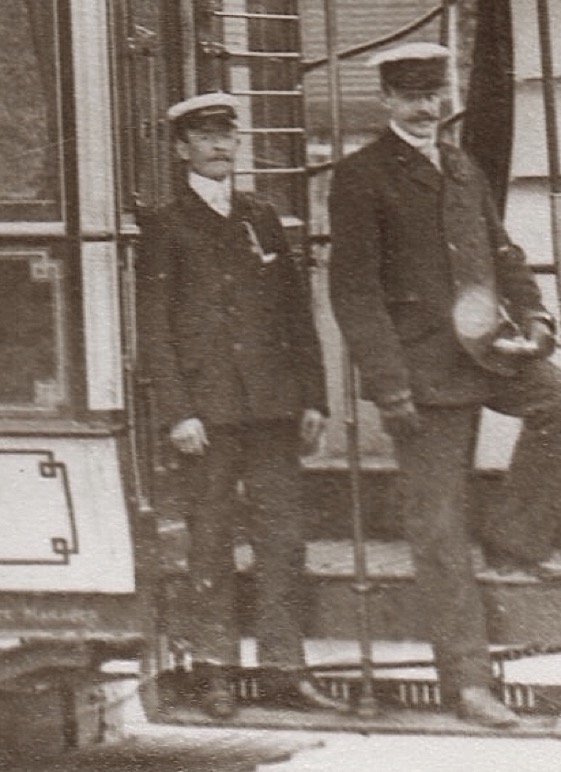
An enlargement of the 1903 shot of Tramcar No 25 above, showing the motorman (right) and a figure who may well be an inspector (left). If so, then the uniform would seem to have been virtually identical to that worn by tramcar crews, probably only differing in respect of the embroidered grade badges.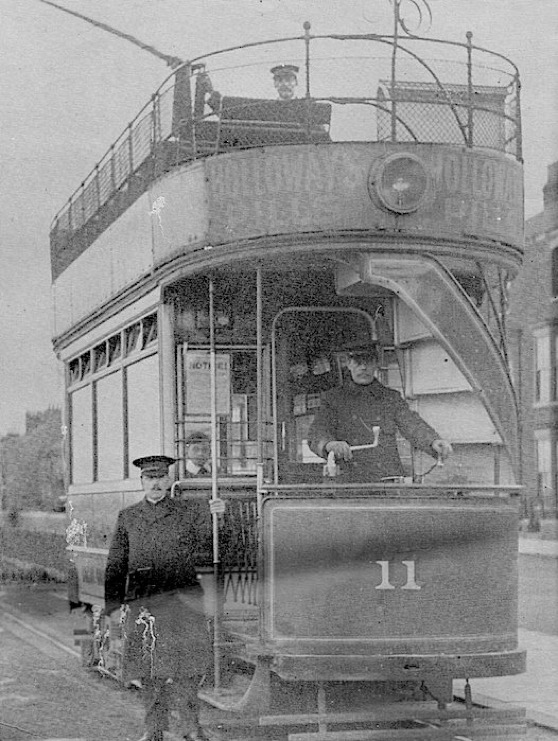
Tramcar No 11 with a figure (left) who is in all probability an inspector (the conductor is on the top deck) — photo undated, but probably early Edwardian. In common with the tramcar crew, he appears to be wearing a coat and cap without obvious insignia — photographically — suggesting that if they did bear badges, that they were embroidered. Photo courtesy of the Jill Smith Collection. 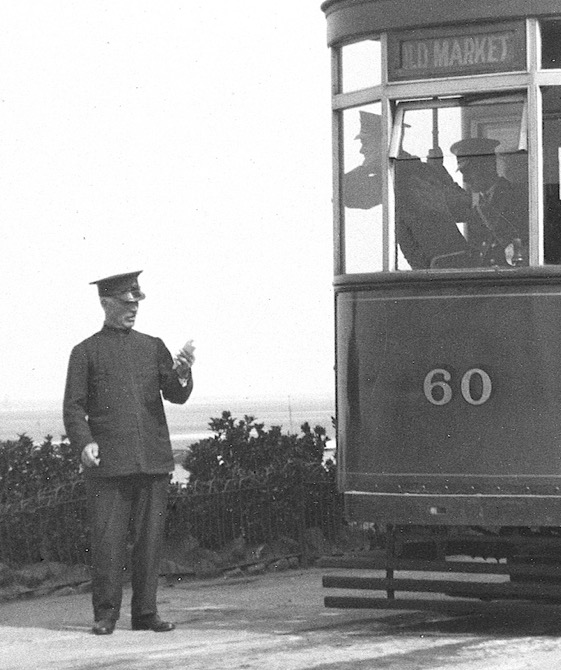
Inspector Tom Clements consults his notebook at Kingsway terminus in Cleethorpes on 25th June 1933, whilst conversing with the crew of Tramcar No 60; he is wearing typical tramway inspector garb with a tensioned-crown peaked cap. Tom Clements was born in 1877 in Somerset and worked as a motorman for the Bristol Tramways and Carriage Company, electric services being introduced there in 1895. When he came to Grimsby, he apparently trained the new GGSTCo motormen, and also drove the first electric tram. He stayed on in Grimsby, marrying Ellen Griffiths (of Carmarthen) in 1903 and having three children; he eventually became an inspector and died, still living in Grimsby, in 1964. I am indebted to Margaret Fisher, Tom Clements' granddaughter, for the background information. Photo by M J O'Connor, with thanks to the National Tramway Museum.
Female staff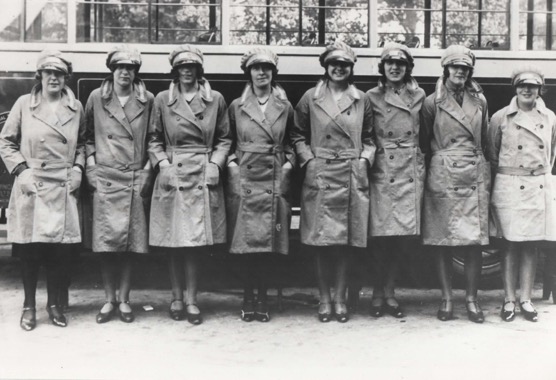
A group of Provincial Tramways Company bus conductresses at Park Road depot — photo undated, but almost certainly taken in the 1920s. The 'Provincial' was the GGTCo's parent company, and in Grimsby, chose to run buses under its own name, probably for legal reasons. Whether these uniforms in any way reflect those worn by the ladies who worked on the trams, is currently unclear. Photo courtesy of the Jill Smith Collection.